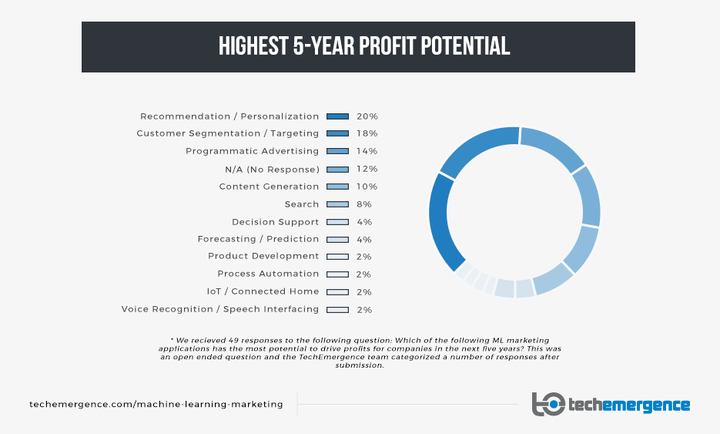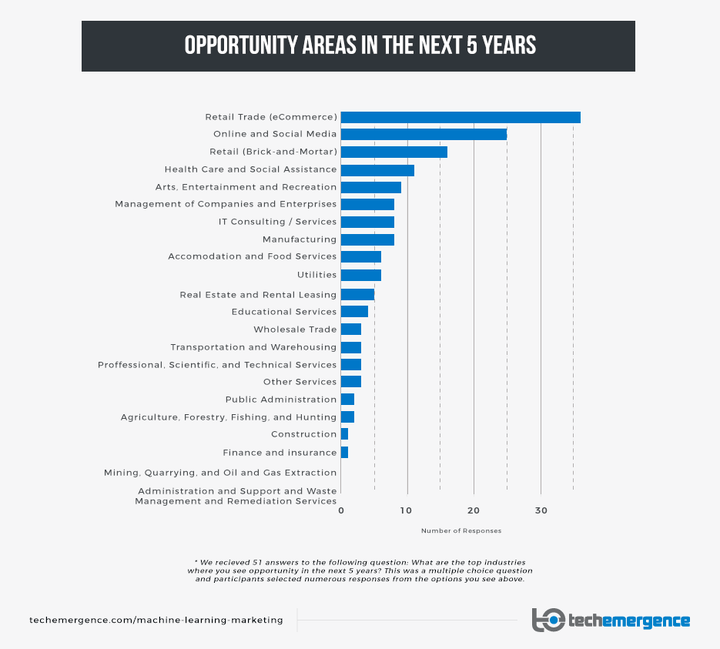Big consumer data has positioned the marketing industry to reap the fruits of machine learning solutions in ways that few other industries are able. Machine learning, paired with marketing’s versatile and innovative nature, has helped propel new strategies and technologies at comparative light speed over the last half decade, which prompted us to wonder: What are the applications and industries most likely to benefit from machine learning in another five years?
We asked this and a number of related questions in our latest survey of 51 executives who are using AI and ML applications in marketing. Their responses yielded insights on current trends—smart search is ubiquitous— and emerging trends half-a-decade into the future, where the typical brick and mortar experience may find a sweet spot in blending the physical with a smart virtual experience.
AI Marketing Applications – Current Profit Potential
Our first question, to give some context to the future, asked participants to select the AI and ML marketing applications they believed to be the most profitable today. Responses selected on a scale from 1 to 4 (with 4 being the most profitable), and we’ve highlighted all that had an average response of 3.5 or above:
- Search
- Customer Segmentation/Targeting
- Recommendation Engines
- Programmatic Advertising (using software, as opposed to humans, to purchase digital ads)

The above selections seemingly align with machine learning technology now available at scale; of course, this doesn’t mean that ML technologies are not available in other areas, such as image or speech recognition, only that search and customer segmentation, for example, progressed more quickly and hence had earlier adoption. Focus is on the B2C marketing as opposed to B2B marketing, which is perhaps not surprising but still worth emphasizing.
Smarter conversational search—semantic and contextual—made a breakthrough in 2013 with Google’s “Hummingbird algorithm”, which focused attention on individual words in the context of the meaning of the whole sentence. Neil Patel provides some examples of what current semantic search looks like—including queries and results that provide contextual comparisons, auto-corrected misspellings, and information as images/graphics—all of which contribute to more relevant and direct paths to products, services, and related ideas in the consumer’s search.
Personalized and relevant marketing also came out on top for current profitability potential. Mihir Nanavati, Senior Vice President of Product at Kahuna, believes the companies that will rise to the top in today’s market are the “businesses that are laser focused on increasing relevance and personalization of communication to consumers.” Similarly, Director of Suzu Technologies Claudiu Soare noted that omni-channel (multiple channels, such as physical store, laptop and mobile, social media, etc.) and personalization capabilities as distinguishing factors for today’s serious players in the modern B2C market.
In addition to targeting customers based on inferred wants and needs, a compelling facet of personalization is something Forrester Research identifies as “Operationalizing Emotion”, which alludes to customers making purchasing decisions based as much (or more) on emotional experiences than on rational conclusions. Today’s market is all the more risky for companies that don’t provide a stellar customer experience from start to finish, and it’s becoming more common for businesses to suffer longer-term revenue losses for a single negative experience, whether directly experienced by the customer or based on empathy for others’ experiences. A quick and personalized response to any customer dissatisfaction seems almost an essential application for businesses that want to stay afloat for the long-haul.
In terms of types of businesses profiting in the current market, Andy Zimmerman, chief marketing officer at Evergage, stated—”Consumer retail businesses have the most to gain because of the volumes they deal with and the direct and immediate opportunity for purchase transactions.” While many eCommerce businesses, including giants like Amazon and eBay, have built their business around such data, Melody Gambino, director at Grapeshot, believes that traditional brick and mortar have much to gain in this area.
“Brick and mortar retail has an incredible opportunity to increase their reach, precision, track mobile/digital impressions to in-store and online conversions, learn the customer journey details, etc.,” she says. The trend of marketing to customers while in-store is identified as a number one trend for 2017 by Data & Marketing Association (DMA), naming it as a tool tied to mobile use; DMA finds that 80 percent of millennials are on their phone in-store and that 74 percent are willing to receive location-based alerts. Companies that are open to experimenting with smart mobile applications for millennials and other targeted audiences may find virtual gold mines in the very near future.
Industries and Applications with AI Marketing Potential in 5 Years
Many eCommerce stores and social media channels are already leveraging the top 3 selected applications for future potential to different effects, technology that is also largely dependent on available expenditure, although cloud-based software is starting to even the playing field:
- Recommendation/Personalization
- Customer Segmentation/Targeting
- Programmatic Advertising

The selection of programmatic advertising aligns with a new report recently released by Zenith Media, which concluded that programmatic ad buying would grow by 31 percent in 2017, the fastest of all digital media channels (including social media and online video). Programmatic advertising has grown significantly since its 13 percent market share in 2012, predicted to peak at $64bn in 2018. This report also found that the US market was by far the biggest programmatic ad spender, accounting for $24bn or 62 percent of the global market, and followed by the UK at $3.3bn.
Honing in on specific industries, retail trade was identified by our participants as still leading in 5 years, arguably having evolved and profited from more personalized targeting, smarter recommendation and decision engines, and programmatic advertising. The top 3 industries selected out of 51 total responses included:
- Retail Trade eCommerce (all 51 responses)
- Online and social media (a difference of 15 responses)
- Retail (Brick & Mortar) (a difference of 8 responses)

Projected applications ripe for potential in these industries, as identified by our participants, included contextual intelligence-based products and smarter decision engines. Tom Vandendooren, chief business development officer at Sentiance, believes that contextual intelligence will be one wave of future profitability, “ as it will drive the next revolution in customer engagement (from segmentation to personalization to contextualization).”
Contextual intelligence helps paint a multidimensional profile of customers and is powered by predictive analytics, with algorithms now able to learn in real-time as outlined by Boxever’s Senior Data Scientist Dominik Dahlem. He emphasizes that transactional and demographic data are no longer enough, and that the focus is shifting to having real-time data that provides higher accuracy and relevance in customer profile creation.
A new technology in 2006, decision engines have continued to evolve with advances in machine learning algorithms. John Callan, vice president of marketing at Boxever, believes that machine learning technology will continue to advance and make decision engines all the more important for earning a profit in five years “because of their ability to...become more effective based on the feedback from the decision/offer/message that has been delivered.”
We think it’s also worth revisiting and ending on the brick-and-mortar business, which seems to have optimum potential to gain marketshare by applying integrated and omni-channel ML applications—like location-based alerts and smart ads—and help change the face of the industry. In 5 years, bigger chains may be pioneering new methods of customer engagement, prompting customers to interact with user interfaces (both ads and search) in seamless new ways, such as voice and gesture via augmented reality. It seems probable that marketing will be increasingly woven into the fabric of our everyday experiences, acting as a personal concierge or guide of sorts, and exerting a greater influence over our purchase-related actions than ever before.
